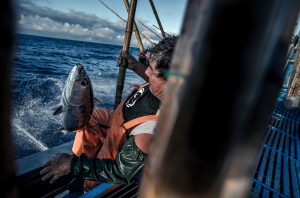The Azores is an archipelago comprising nine main islands that cover approximately 2,333 square kilometers of land. These islands are São Miguel, Terceira, Pico, Faial, São Jorge, Santa Maria, Graciosa, Flores, and Corvo. Located in the middle of the Atlantic Ocean at the crossroads of the Gulf Stream and the North Atlantic Drift, the Azores is home to one of the most popular fishing destinations in the world. The abundance of nutrients brought in by ocean currents attracts a variety of fish species to the area as they migrate across the Atlantic.

Fishing for tuna using handlines dates back to the 16th century, and the pole and line fishery as we know it today only started in around 1950. Azorean emigrants, from the United States brought ship plans and new fishing gears back to the islands and since then, the fishery has remained practically unchanged. Today, the Azores fishing fleet is largely made up of small vessels and, in terms of tuna fishing, uses largely pole-and-line methods. Monitoring and traceability form an integral part of this fishery. Fishing trips are monitored by an observer from the Azores Fishery Observer Programme (POPA). POPA is responsible for collecting scientific data on fishing vessels, including information on the target species as well as any bycatch.
 The Azores is home to over 240,000 inhabitants and fisheries represent about 3.8% of the regional economy providing work for fishers, factory workers (which are mostly women-run), and shipyards across different islands. There are three IPNLF members based in the Azores, namely, Associação de Produtores de Atum e Similares dos Açores (APASA), Pão-do-Mar, and Federação das Pescas dos Açores (FPA). All three members are long standing fisheries related associations in the Azores that are working towards better representation, with the aim of safeguarding the social, environmental and economic activity of the fishery.
The Azores is home to over 240,000 inhabitants and fisheries represent about 3.8% of the regional economy providing work for fishers, factory workers (which are mostly women-run), and shipyards across different islands. There are three IPNLF members based in the Azores, namely, Associação de Produtores de Atum e Similares dos Açores (APASA), Pão-do-Mar, and Federação das Pescas dos Açores (FPA). All three members are long standing fisheries related associations in the Azores that are working towards better representation, with the aim of safeguarding the social, environmental and economic activity of the fishery.
The Azores fishery achieved plastic-neutral status in 2022 after the successful implementation of a Plastic Neutrality Competition jointly supported by Biocoop and Fish4Ever. Three months into the competition, the Azorean vessels had retrieved 875 times more ghost gear in weight than they lost annually in their own fishing operations.
As the world grapples with challenges posed by industrial overfishing and the degradation of marine habitats, the Azores Tuna Fishery serves as testament to the potential of one-by-one fisheries to safeguard our oceans for generations to come.